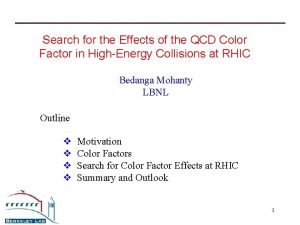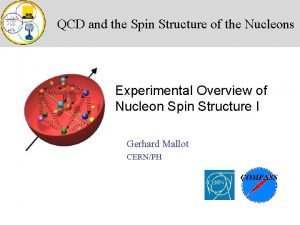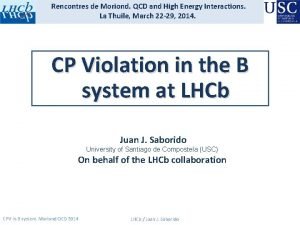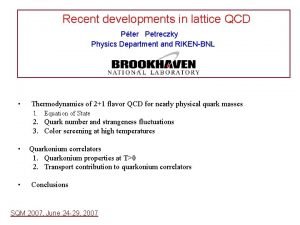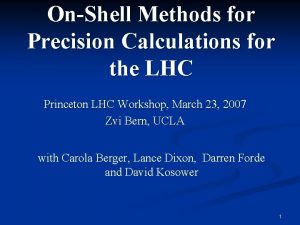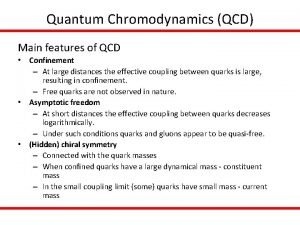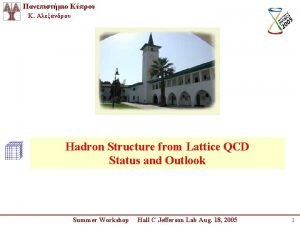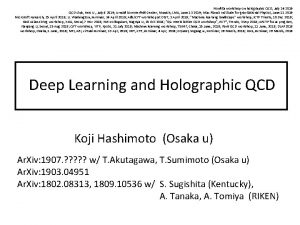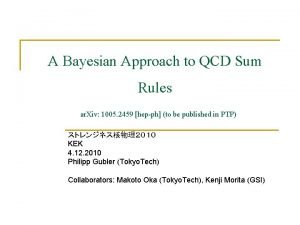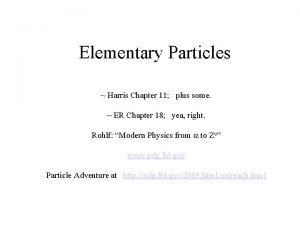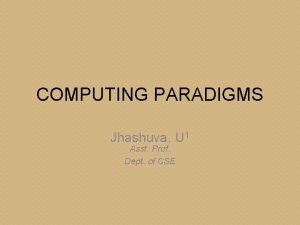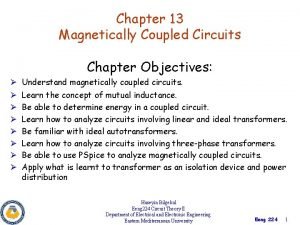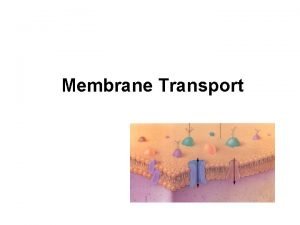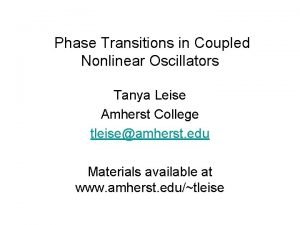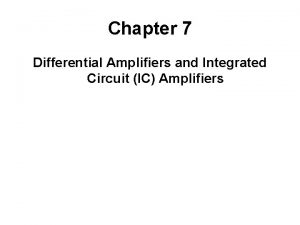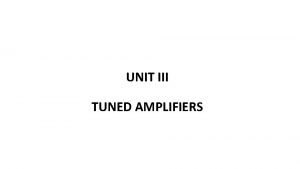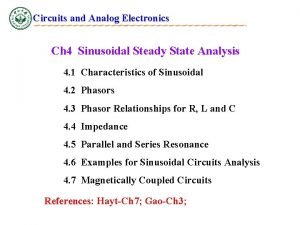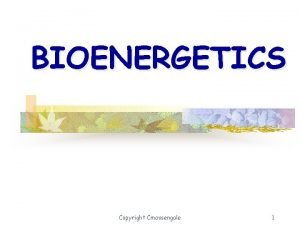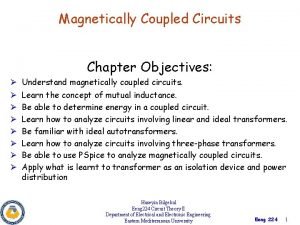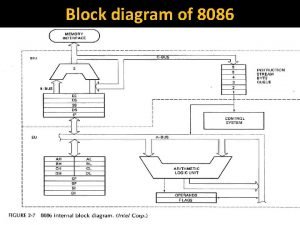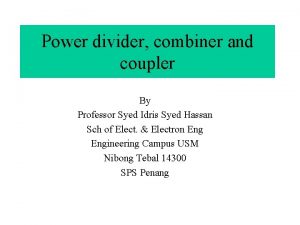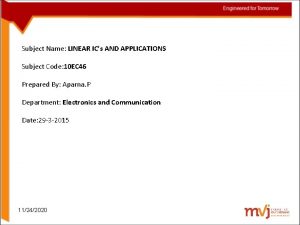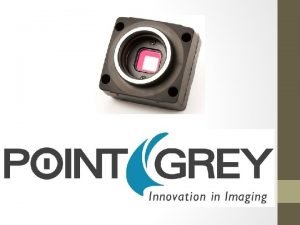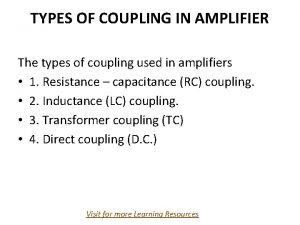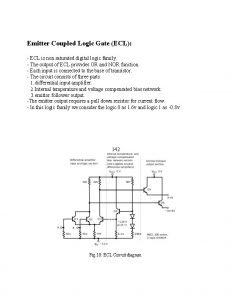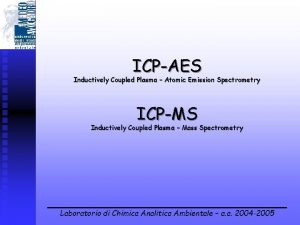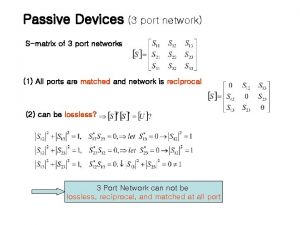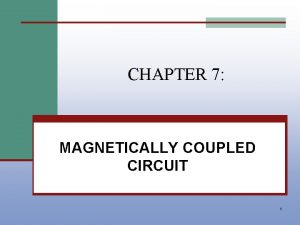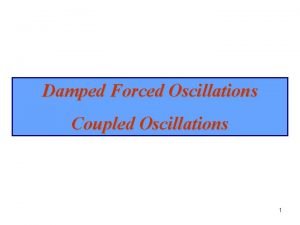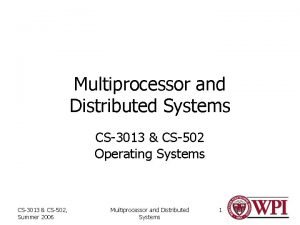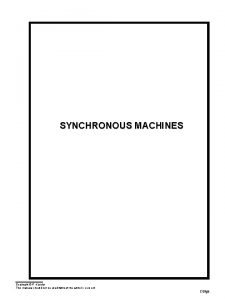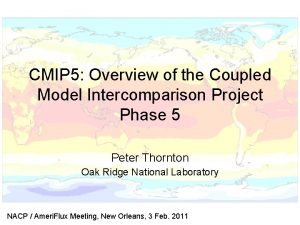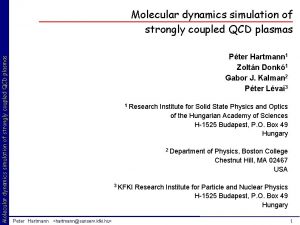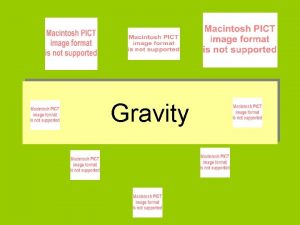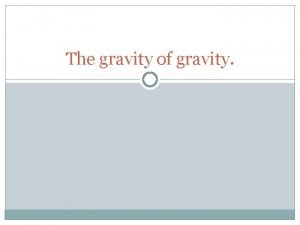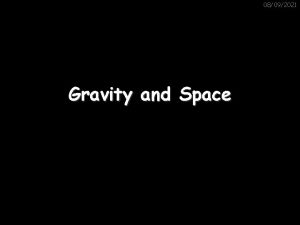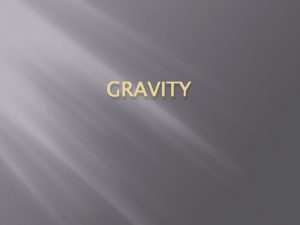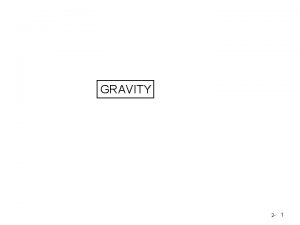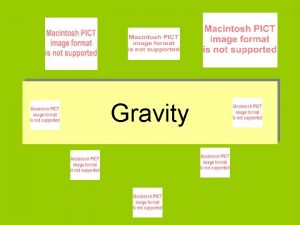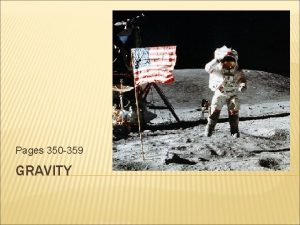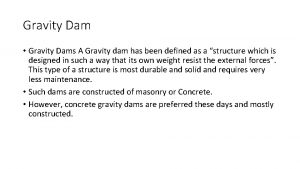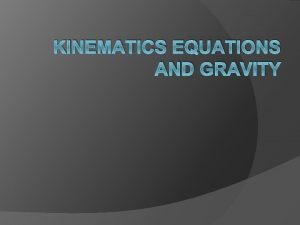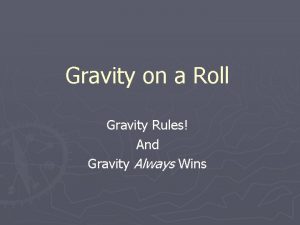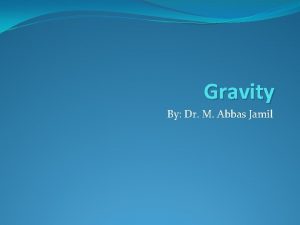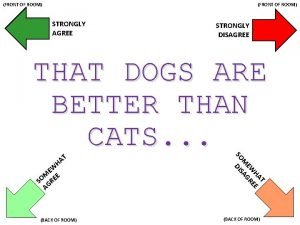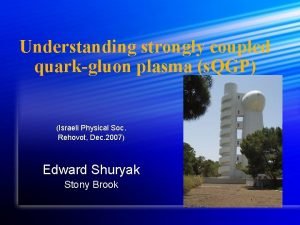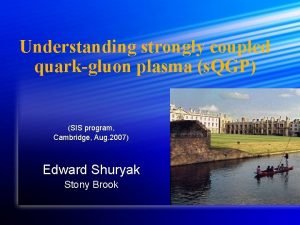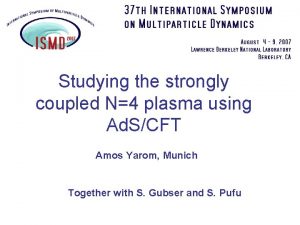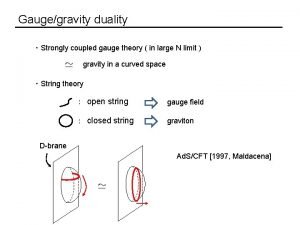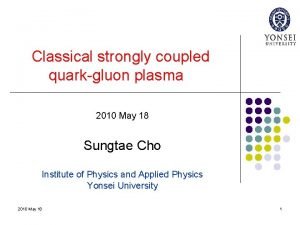From Einsteinian gravity to strongly coupled QCD via












































- Slides: 44

From Einsteinian gravity to strongly coupled QCD via Ad. S/CFT (Einstein Coll. Rehovot, Dec. 2007) Edward Shuryak Stony Brook

Einstein We should be happy to see a bit of Einstein in each other, even if it measures in milligramms! l Why this picture? He seems to be less professorial and happier than in most other photos The beach looks like Stony Brook (? ) where he indeed rented for l few summers. He was at those beaches when was asked to write the famous letter to Roosevelt

Outline RHIC findings -- collective flows and jet quenching -- QGP is very strongly coupled! What exactly it means? The puzzle: q Ad. S/CFT intro. Understanding analogs for Coulomb/Ampere. . Laws at strong coupling q Viscosity and diffusion constant from Ad. S/CFT q Calculating the “hologramm” for a dipole, conical flow, a falling string => gravity dual for high energy collisions q Creation of black holes: new meaning of dissipation q transport summary; two explanations -Ad. S/CFT and s. QGP with monopoles - seem to work. q Summary:

The main puzzle: Quark-Gluon Plasma is unusual matter • RHIC experiments (2000 -now) Au. Au at 200 Ge. V/N • QGP fireball of few 103 particles behaves hydrodynamically • Viscosity 10 times lower than of anything else: the best known liquid! • Jets lose energy very strongly --drag force is order of magnitude larger than expected from kinetic estimates, • Same for heavy quarks • Energy is not going into forward cone of radiation, as expected perturbatively, but to a ``conical flow”

Sonic boom from quenched jets Casalderrey, ES, Teaney, hep-ph/0410067; H. Stocker… • the energy deposited by jets into liquid-like strongly coupled QGP must go into conical shock waves • We solved relativistic hydrodynamics and got the flow picture • If there are start and end points, there are two spheres and a cone tangent to both Wake effect or “sonic boom”

Two hydro modes can be excited (from our linearized hydro solution): a ``diffuson” a sound

PHENIX jet pair distribution Note: it is only projection of a cone on phi Note 2: there is also a minimum in <p_t(phi)> at 180 degr. , with a value Consistent with background The most peripheral bin, here there is no QGP

Ad. S/CFT from gravity in Ad. S 5 to strongly coupled CFT (N=4 SYM) plasma what people dream about for LHC experments -- a black hole formation -does happen, in each and every RHIC Au. Au event => thermalization, All information falls into black hole: only total entropy=area of newly formed b. h. horizon = remains …

The first gauge-string duality found in 1997 l Ad. S/CFT correpondence known as ``Maldacena duality” l Along the long path illuminated by Witten, Polyakov, Klebanov…

The duality setting • CFT (conformal gauge theory) N=4 SYM a cousin of QCD (chromodynamics=theory of strong interaction) in which the coupling =g 2 Nc does not run. • It lives on the 4 -dim boundary of 5 -d curved Ad. S (anti-de-Sitter) space where (super)gravity is a description of (super) string theory • Correspondence dictionary: everything in the “bulk” reflects on the boundary • Hint; think of extra dimension as a complex variable trick: instead of functions on the real axes one may think of poles in a complect plane and get math to simplify the problem.

What “strongly coupled” means • QED e 2/hbar c=1/137<<1 • Atoms and positronium are weakly bound E=me(1 - rel. corr • What happens as grows? Klein-Gordon (Dirac) eqns predict particles fall at each other (1 s state falls at and then other levels as it grows • Strong coupling is large g 2 Nc= Nc>>1 yet Ad. S/CFT told us charges do not fall and 1 s state has energy O(M/sqrt(

The 5 th coordinate • z is the 5 th coordinate, dim=length=1/momentum • its physical meaning is ``scale” as in renorm. group • z=>0 is ``high scale” UV or very high energies, z=>infinity is low scale or IR • ds 2 =(-dt 2+dx 12 +dx 22 +dx 32 +dz 2)/z 2 so distances in z are logarithmic. Light speed is still 1 in all directions • Gravity force is acting toward large z, so “stones” fall there

The story of Maldacena’s dipole (example of how little we understand N=4 SYM) • Maldacena, Rey, Yee -98 one of the first apps: • The pending string (=flux tube) has minimal action • Modified Coulomb law at strong coupling, sqrt of the coupling << coupling • Can it be just a factor, like dielectric constant? z

Can one get it resumming diagrams? • ‘t. Hooft said large Nc leads to planar diagrams, but nobody knows how to do it • Semenoff and Zarembo hep-th/0202156 summed ladder diagrams, � The lesson: ES, Zahed hep-th/0308073 Parametrically short time of color correlation, or effective Velocity >>1


More on the dipole in a stronly coupled vacuum • Shu Lin, ES ar. Xiv: 0707. 3135 recently evaluated holographic stress tensor from the Maldacena string • T 00 ->d 3/r 7 Times function of the Angle which is plotted On the right

• Previously Callan&Guijosa calculated a scalar ”dilaton image” • (F 2 =d 3/r 7 and no angular function • Why extra d/r? Klebanov, Maldacena, Thorn hep-th/0602255 : for the same reason as 1/sqrt( short time of color correlations! Fields of both charges can only cancel each other if emitted nearsimulaneously • Thus it is not just a dielectric constant, r and angular depenedence are also changed!

One can also do charge+monopole • J. Minahan 98 E=- f(g 2/4 ) sqrt(N)/L with self-dual f(g 2/4 ) = f(1/(g 2/4 ) • We calculated stress tensor from this configuration • In weakly coupled gauge theory Poynting T 0 i rotates around the line of two charges (J. J. Thomson) but we found it to be zero at strongly coupled CFT!

viscosity from Ad. S/CFT (Polykastro, Son, Starinets 03) Kubo formula <Tij(x)Tij(y)>=> • • • Left vertical line is our 4 d Universe, (x, y are on it) Temperature is given by position of a horizon (vertical line, separationg From interier of``black brane” T=T(Howking radiation) (Witten 98) • Correlator needed is just a graviton propagator G(x, y) • Blue graviton path does not contribute to Im G, but the red graviton path (on which it is absorbed) does Both viscosity and entropy are proportional to b. h. horizon, thus such a simple asnwer

Heavy quark diffusion J. Casalderrey+ D. Teaney, hep-ph/0605199, hep-th/0701123 One quark (fisherman) is In our world, The other (fish) in Antiworld (=conj. amplitude) String connects them and conduct waves in one direction through the black hole A N T I W O R L D

Heavy quark in CFT plasma has a string deformed by ``hot wind” Herzog, Yaffe, Gubser…May 06 calculated the drag force = momentum Flow down the string Einstein relation between Drag and diffusion is Fulfilled: But how graviy knows?

subsonic from P. Chesler, L. Yaffe (also Gubser et al have detailed papers On this) Both groups made amazingly detailed Description of the conical flow from Ad. S/CFT=> supersonic Note that it is not hydro but direct soluiton: one can e. g. Be sure the shape of the wave is correct Even at micro scales

Gravity dual to the (heavy quark) collision: “Lund model” in Ad. S/CFT (Lin, ES hep-ph/0610168) If colliding objects made of heavy quarks • Stretching strings -- are falling under the Ad. S gravity and don’t break • analytic solution at v<v(critical) which then gets classically unstable • Numerical solutions at all v<1 • We get (the first time-dependent) hologramm of falling string by solving linearized Einstein eqn for one (and many) strings and found nonhydrodynamical explosion observed in our 4 d world Ad. S 5 Center= Extremal b. h.

• Holographic image of a falling string • (as far as we know the first timedependent hologramm) • T 00 , Toi • Cannot be reprensented as hydrodynamical => anisotropic pressure in the ``comoving frame”

Gravity dual for the heavy ion collisions • Ad. S metric corresponds to extreme BH (mass is minimal for its charge and no horizon) • As collision creates falling “debris”, they will form a non-extreme BH with a horizon Nastase 03 • This can only be done via non-linearized Einstein eqns • Expanding/cooling fireball= departing horizon (Sin, ES and Zahed 04, …) • Asimptotic late-time solution in 1+1 dim is found , stretching BH (Janik-Peschanski 05)

New meaning of dissipation • Relaxation=formation of a horizon (trapping surface) where information is lost • Its area gives the entropy: • (is it true for dynamically stretched t-dependent horizon? Yes to PJ leading order only) • It returns pure thermal Hawking radiation => with hydrodynamical hologramm • W. Israel => collapsing shell gets heated, explains the origin of entropy production

Another duality for s. QGP: electric/magnetic fight Fraction of quasiparticles are magnetically Charged (monopoles and dyons) At T<Tc they somehow (? ) make a “dual superconductor” =>confinement.

An example of ``dyonic baryon”=finite T instanton top. charge Q=1 config. , dyons identified via fermionic zero modes Berlin group - Ilgenfritz et al Red, blue and green U(1) fields 3 dyons with corresp. Field strengths, SU(3), Each (1, -1, 0) charges

Electric and magnetic scrrening Masses, Nakamura et al, 2004 My arrow shows the ``self-dual” E=M point Me<Mm Magnetic Dominated At T=0 magnetic Screening mass Is about 2 Ge. V (de Forcrand et al) (a glueball mass) Other data (Karsch et al) better show Me Vanishes at Tc Me>Mm Electrric dominated ME/T=O(g) ES 78 MM/T=O(g^2) Polyakov 79

New (compactified) phase diagram describing an electric-vs-magnetic competition Dirac condition (old QED-type units e^2=alpha, deliberately no Nc yet) <- n=2 adjoint Thus at the e=g line Near deconfinement line g->0 in IR (Landau’s U(1) asymptotic freedom) e-strong-coupling because g in weak! => Why is this diagram better? => There are e-flux tubes in all blue region, not only in the confined phase! In fact, they are maximally enhanced at Tc

Strong coupling in plasma physics: Gamma= <|Epot|>/<Ekin> >>1 gas => liquid => solid • This is of course for +/- Abelian charges, • But ``green” and ``anti -green” quarks do the same! • local order would be preserved in a liquid also, as it is in molten solts (strongly coupled TCP with <pot>/<kin>=O(60), about 3 -10 in s. QGP)

Gelman, ES, Zahed, nuclth/0601029 With a non-Abelian color => Wong eqn Gas, liquid solid

So why is such plasma a good liquid? Because of magnetic-bottle trapping: static e. Dipole+MPS Note that Lorentz force is O(v)! E+ + M V E- - Monopole rotates around the electric field line, bouncing off both charges (whatever the sign)

We found that two charges play pingpong by a monopole without even moving! Chaotic, regular and escape trajectories for a monopole, all different in initial condition by 1/1000 only! Dual to Budker’s magnetic bottle

MD simulation for plasma with monopoles (Liao, ES hep-ph/0611131) monopole admixture M 50=50% etc again diffusion decreases indefinitely, viscosity does not It matters: 50 -50 mixture makes the best liquid, as it creates ``maximal trapping

short transport summary log(inverse viscosity s/eta)- vs. log(inverse heavy q diffusion const D*2 pi. T) (avoids messy discussion of couplings) ->Stronger coupled -> • • RHIC data: very small viscosity and D vs theory - Ad. S/CFT and MD(soon to be explained) Most perfect liquid 4 pi MD results, with specified monopole fraction Weak coupling end => (Perturbative results shown here) Both related to mean free path 50 -50% E/M is the most ideal liquid

From RHIC to LHC: (no answers, only 1 bn$ questions) (I don’t mean the price of LHC but ALICE) l Will ``perfect liquid” be still there? l Is jet quenching as strong, especially for c, b quark jets and much larger pt? l Is matter response (conical flow at Mach angle) similar? (This is most sensitive to viscosity…)

Conclusions Strongly coupled QGP is produced at RHIC T=(1 -2)Tc l This is the region where transition from magnetic to electric dominance happen l at T<1. 4 Tc still Lots of magnetic objects => E-flux tubes l l. Good liquid because of magneticbottle trapping l. Classical MD is being done, the lowest viscosity for 50 -50% electric/magneti c plasma Ad. S/CFT => natural applications of string theory, N=4 SYM is not QCD: nonconfining and Strongly coupled, s. QGP is OK l RHIC data on transport l (eta, D), ADS/CFT and classical MD all qualitatively agree! l Are these two pictures related?

reserve

Effective coupling is large! alphas=O(1/2 -1) (not <0. 3 as in p. QCD applications) t. Hooft lambda=g 2 Nc=4 pi. Nc=O(20)>>1 -1 Bielefeld-BNL lattice group: Karsch et al

Bose-Einstein condensation of interacting particles (=monopoles) (with M. Cristoforetti, Trento) l Feynman theory (for liquid He 4): polygon jumps BEC if exp(-∆S(jump))>. 16 or so (1/Nnaighbours) We calculated ``instantons” for particles jumping paths in a liquid and solid He 4 incuding realistic atomic potentials and understood 2 known effects: (i) Why Tc grows with repulsive interaction<= because a jump proceeds faster under the barrier (ii) no supersolid He => density too large and action above critical Marco is doing Path Integral simulations with permutations numerically, to refine conditions when BEC transitions take place Jumping paths: Feynman, interacting

At e=m line both effective gluons and monopoles have masses M about 3 T exp(3)<<1 is our classical parameter (Boltzmann statistics is good enough) l At T=Tc monopoles presumably go into Bose. Einsetein condensation => new semiclassical theory of it for strongly interacting Bose gases, tested on He 4 l (M. Cristoforetti, ES, in progress) l

Bose condensation versus repulsive scattering length

BEC (confinement) condition for monopoles For charged Bose gas (monopoles) the action for the jump can be calculated similarly, but relativistically; jumps in space d and in time Comparable) ∆S=M sqrt(d 2+(1/Tc)2)+ ∆S(interaction) = Sc =1. 65 -1. 89 (first value from Einstein ideal gas, second from liquid He) provides the monopole mass M at Tc M Tc approx 1. 5 => M as low as 300 Me. V
 Gravity for dummies and dummies for gravity equations
Gravity for dummies and dummies for gravity equations Decimo quinta estacion via crucis
Decimo quinta estacion via crucis Palavras convergentes
Palavras convergentes Via negativa
Via negativa Significado de via lucis
Significado de via lucis Via piramidal primera y segunda neurona
Via piramidal primera y segunda neurona Color factor qcd
Color factor qcd Qcd
Qcd Rencontres de moriond
Rencontres de moriond Qcd
Qcd Qcd penrose
Qcd penrose Confinement qcd
Confinement qcd Qcdst
Qcdst Qcd
Qcd Qcd
Qcd Qcd sum rules
Qcd sum rules Qcd lagrangian
Qcd lagrangian Qed qcd qfd
Qed qcd qfd All resources are tightly coupled in computing paradigm of
All resources are tightly coupled in computing paradigm of Coupled circuits
Coupled circuits Coupled transport example
Coupled transport example Tanya leise amherst
Tanya leise amherst Emitter coupled differential amplifier
Emitter coupled differential amplifier Working of rc coupled amplifier
Working of rc coupled amplifier Netflix culture freedom & responsibility
Netflix culture freedom & responsibility Classification of tuned amplifier
Classification of tuned amplifier Complex impedances
Complex impedances Coupled reaction
Coupled reaction Magnetically coupled coils
Magnetically coupled coils Block diagram of loosely coupled configuration
Block diagram of loosely coupled configuration Coupled line coupler
Coupled line coupler Capacitor coupled non inverting amplifier
Capacitor coupled non inverting amplifier Charge coupled device
Charge coupled device Example of a claim of value
Example of a claim of value Advantages of rc coupling
Advantages of rc coupling Standard free energy change
Standard free energy change The ecl circuits usually operates with
The ecl circuits usually operates with Inductively coupled plasma
Inductively coupled plasma Highly aligned loosely coupled meaning
Highly aligned loosely coupled meaning 3 port network
3 port network Magnetically coupled circuits lecture notes
Magnetically coupled circuits lecture notes Coupled oscillations
Coupled oscillations Tightly coupled multiprocessor
Tightly coupled multiprocessor Machine dynamics
Machine dynamics Coupled model intercomparison project phase 5
Coupled model intercomparison project phase 5






